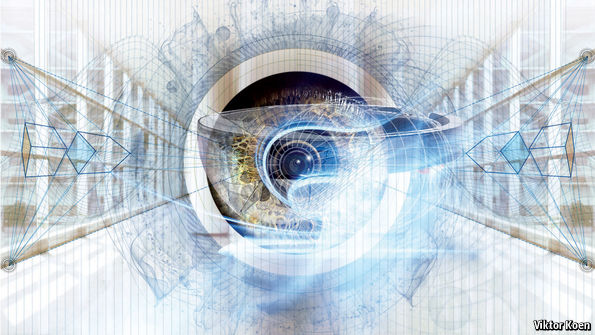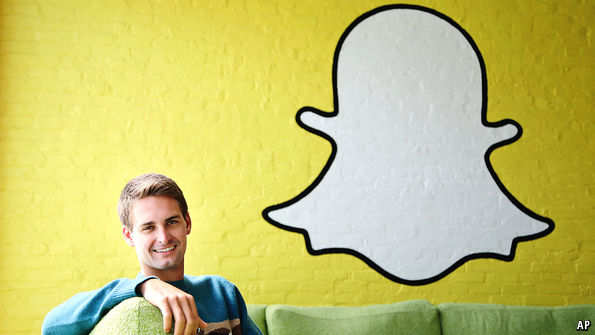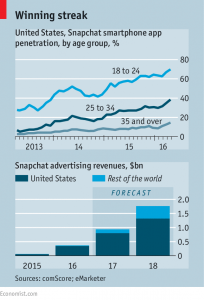Reality, only better
The promise of augmented reality
from The Economist

SF predicts the future and influences the technologists. Mobile phones are real-life versions of the hand-held communicators in “Star Trek”
If companies like Microsoft, Google, Magic Leap and Meta have their way, the next thing to leap from fiction to fact will be AR
AR will take three-quarters of the $108 billion a year which Digi-Capital predicts will be spent by 2021 on VR and AR combined
Now, as computers have shrunk and become powerful enough, it has become possible to give people the same experience as their daily lives
Last year, the world was briefly entranced by an AR smartphone game called Pokémon Go. Apps such as Snapchat are another example.
Google’s Translate app employs automatic translation and a smartphone’s camera to show an image with text interpreted into other languages
Snapchat and Translate rely on machine-vision algorithms. Snapchat is designed to detect faces. Translate looks for text in the world
Google and Lenovo unveiled a Tango-enabled phone which can model a house, an office or any other space upon which it can draw things
An app for Tango, “Measure”, overlays a virtual tape measure on a phone’s screen. “Woorld” lets users fill their rooms with virtual objects
Tango is impressive but is still in its early stages. AR may not take off until smartphones can be abandoned in favour of smart spectacles
Such glasses do exist. So far, though, they have made a bigger impact on the workplace than in the home
Boeing is using AR glasses to give workers in its factories step-by-step instructions. The result is faster work with fewer mistakes
Google’s “Glass” did not go well. The idea of it was to create a wearable smartphone, all the while leaving his hands free for other tasks
Google stopped making Glass in 2015 on privacy grounds, although it is working on a new version aimed at businesses instead of individuals.
RideOn, an Israeli company, will start selling AR ski goggles which turn skiing into a video game by showing users routes
Unlike Google’s Glass, Microsoft’s HoloLens can draw 3D images that appear to exist in the real world
It is like a Tango-enabled smartphone whose cameras scan the world around it and generate such a flood of information
Unlike VR headsets, HoloLens is a self-contained computer that needs no accessories
By overlaying its images onto the real world, the HoloLens headset turns reality into a computer monitor
The first demonstrations of the HoloLens involved games. More recent apps have focused on business and training like an anatomy practice
HoloLens can be used collaboratively, as well. A guide can see what the HoloLens user sees and put circles around objects of interest
Aecom is already using the HoloLens to help design very complicated modern buildings
In 2016 Aecom designed buildings with complex roofs which they couldn’t check on a 2D screen. But HoloLens let them all review it together
The HoloLens is far from perfect. It is bulky, unfashionable and expensive. The view is too small, and the gesture-tracking system is clunky
One rival of Microsoft is Meta whose AR headsets will have a much wider field of view and recognize more hand gestures than HoloLens
Magic Leap has attracted $1.4 billion in investment from Google and Ali Baba. The demos it has released show images clearer than HoloLens
AR is still at an early stage, especially as a consumer technology. Market forecasts of AR might be too exaggerated as well as ones of VR
Even among techies, enthusiasm for VR seems limited. A survey by Steam found that just 0.38% of its customers owned a VR headset in December
Consumer versions of AR should be adapted for peoples’ phones. But a phone’s screen is small, fiddly and tedious to use for AR apps
Mark Zuckerberg thinks VR and AR headsets will be like normal-looking glasses. Samsung and Apple are exploring the idea of AR contact lenses
None of the present approaches to AR seems to change the world as iPhone did. But those behind them hope that a combination of them will
| 2017/02/12
| Science & Technology, Summary
|
The anti-Facebook
Snap’s IPO will be the largest in years
from The Economist

When Snap goes public at an expected valuation of $20bn-25bn its market debut will be the most closely watched since Alibaba floated in 2014
Around 41% of Americans aged 18 to 34 use Snapchat every day, and 150m people globally spend time on it every day
Snapchat is experimenting with new technologies. A large share of people who have used AR will have experienced it on Snapchat
The firm’s IPO prospectus is expected to describe a “camera company”. Its new sunglasses, Spectacles, have caught the attention of analysts
Facebook’s users post permanent records of their lives to a huge circle; Snapchat’s users share impermanent silly images with smaller groups
Snapchat was launched by three students at Stanford University in 2011. It lay undiscovered until high-school girls started using it
Mr Spiegel is good at devising and evolve Snapchat’s features which offer elements of scarcity and urgency that bring people back repeatedly
Snapchat shows users how many snaps they have sent and received since joining, and they try to keep this score high
“Lenses” alters the appearance of users using facial-recognition technology. Snapchat has quietly become the most-used AR product
Snap may need to share more data about its users to target ads. Mr Spiegel has indicated that he may be willing to do this
Snap has started to allow advertising in their apps. It insists on keeping creative control and can veto ads look too much
Though Snapchat’s revenue is far below of Google and Facebook, advertisers certainly welcome an alternative to the Facebook-Google duopoly

Yet there are questions over the high stockmarket valuation. The app has yet to establish strong appeal for older users and emerging markets
Snap is expected to point to high user engagement in Western markets with Snapchat rather than global user growth like Facebook and Twitter
Snap’s profit margins may also disappoint because its ads are not automated like Google but tend to rely on a large human salesforce
Mr Spiegel is secretive like Steve Jobs. No one but Mr Spiegel knows all the important details of the firm’s strategy and future plans
Some early backers also privately express concern that the talent pool behind him is not as experienced as they would like
Last summer Instagram owned by Facebook launched its own “stories” feature. Usage of Snapchat stories has declined significantly since then
The public offering stands as evidence that Snap wants to stay independent. But Mr Spiegel must know Facebook and Google could still buy it
If Snap wants to survive as an independent firm, he may need to make some smart acquisitions by buying, say, a visual search firm
| 2017/02/11
| Business, Summary
|
Augmented reality
Why augmented reality will be big in business first
from The Economist

THE history of computers is one of increasing intimacy from mainframe machines to smartphones
The next step is to build a pair of “smart glasses”. AR could bring about a new and more intimate way to interact with machines
For the time being, the most popular AR apps are still found on smartphones. Pokémon Go and Snapchat are using the technology
Microsoft is already running trials of its HoloLens headset in medical schools and architectural practices
AR’s the first problem is aesthetic. The HoloLens’ alien appearance makes its wearers look more creepy than cool
The other problem is consent. In 2013 Google launched its “Glass” headsets. But plenty were worrying that users were covertly filming
Both of these problems are solvable. It may well be possible to build a pair of fashionable AR glasses. Social etiquette also evolves
AR seems likely to follow the same path to popularity as smartphones. The first mobile phones were brick-sized and a target of mockery
| 2017/02/10
| Science & Technology, Summary
|
In a spin
Japan’s government has legalised casinos, but they are not popular
from The Economist

Over ¥23trn ($203bn) is waged annually on pachinko. Pachinko players spend more than the combined betting revenue of all casinos in Macau.
Only 12% of JP citizens supported the legalisation of casinos in Dec. Critics said it would exacerbate problem gambling and attract yakuzas
The construction of casinos could generate ¥5trn in economic activity with another ¥2trn a year from increased tourism.
Foreign casino-operators began lobbying. Bureaucrats are crafting legislation to decide how many resorts to permit and where to put them
Investors fear outbreaks of NIMBYism. In a recent survey 75% of Japanese said they would not like a casino to be built near their homes.
The government wants to double the number of visitors come to JP by 2020, along with the roughly ¥3.5trn that tourists spend annually.
Japan faces regional competition from Macau, Malaysia and Singapore. What will give the country an edge is Japanese culture, or onsen resort
Most Japanese are “emotionally” against casinos and will need to be convinced
| 2017/02/07
| Politics
|
In retreat
The multinational company is in trouble
from The Economist

Donald Trump dislikes multinationals which are shipping jobs and factories abroad and wants to domesticate them
Mr Trump is aggressively attacking multinational companies, which were already in retreat well before the populist revolts of 2016.
Multinational firms employ only one in 50 of the world’s workers. But a few thousand firms influence what billions of people’s lives.
They boomed in the early 1990s. Investors liked global firms’ economies of scale and efficiency. It was a golden age.
For many companies, global reach has become a burden, not an advantage.
With low tax bills, local firms can steal, copy or displace global firms’ innovations without building costly offices and factories abroad.
Governments want global firms for getting wider supply chains, higher R&D abilities and huge amount of tax revenue.
Too big multinationals should shrink or “localise” their businesses, or become “intangible” to survive.
The retreat of global firms will give politicians a feeling of greater control, but it also will make the value of stockmarkets unstable.
The demise of global firms may make the world seem fairer. But it will mean rising prices, diminishing competition and slowing innovation.
| 2017/02/06
| Business, Summary
|






